Abstract
High-voltage transmission towers consist of structures that are designed to avoid the risk of electric shock and prevent the risk of collapse. Hence, for efficiency, they are generally designed as high-rise towers. The main tower posts are the primary structural members that resist loads under various load conditions. Therefore, the contribution of the secondary members to securing the stiffness and strength of the main posts by reducing the effective buckling length is an important one. However, we lack detailed secondary member design criteria. In this study, we observed the structural effects of the horizontal members and braces on the torsional stiffness, elastic buckling strength, and load-carrying capacity of a transmission tower using various structural analysis methods, including linear elastic, eigenvalue, and geometric nonlinear and inelastic analyses, under governing load combinations. According to the analytical results, it is the brace spacing rather than the horizontal members that substantially affects the structural performance. Therefore, we can minimize the number of horizontal members if we erect sufficient brace members. If the brace spacing is wide, then the horizontal members should be erected to create K bracing, thereby enhancing the buckling resistance of the main posts.
1. Introduction
Transmission towers are essential for the transmission of large amounts of energy to decentralized areas. As the energy demand increases, we will require high-capacity transmission towers. Accordingly, as the transmission tower capacities increase, the sizes of the structures increase as well. To ensure the safety of transmission towers, many secondary members are installed, which increases the maintenance costs. Therefore, we need to secure the structural safety and remove excessive members, and we require a design in which the structural safety and maintenance costs are considered.
The necessity for research on the secondary members of transmission towers is increasing. Recently, researchers have conducted many studies on the horizontal members and braces of transmission towers [1,2,3,4,5]. However, they did not assess the secondary member effects on the structural behaviors of transmission towers by analyzing the various parameters. Researchers should conduct analytical studies according to the shape and spacing of the braces and the presence or absence of horizontal members.
Transmission towers resist various load conditions (the load combinations are explained in the ASCE 74) [6]. Many researchers have conducted structural safety studies on transmission towers under various load conditions [7,8,9,10,11,12,13,14], and particularly wind loads [15,16,17,18,19,20,21,22,23].
A transmission tower is a steel structure that is composed of a main post that resists the main loads that are applied to the tower body, and an auxiliary member that supports the main post. The auxiliary member consists of horizontal members and braces. For conventional lattice structures, the horizontal members and braces are expected to maintain the distance between the main post and reduce the effective buckling length, and they also prevent the twisting of the constituting shape. Transmission towers are vulnerable to buckling under external loads owing to the characteristics of steel structures. Hence, researchers have conducted many studies on the buckling of transmission towers [24,25]. Zhang et al. [26] described the importance of preventing buckling by identifying the buckling risk and vulnerable diagonal members.
Albermani et al. [27] conducted a study to improve the load-carrying capacity of a transmission tower by reinforcing the horizontal members. Albermani et al. [28] conducted a study to increase the load-carrying capacity of an existing transmission tower using horizontal members of various shapes, and they verified that the load-carrying capacity increased. In addition, several scholars have described the effects of the horizontal members on enhancing the overall load-carrying capacities of transmission towers [24,25,27,29,30,31,32,33]. We can achieve the structural stability of transmission towers by enhancing the stiffness of the horizontal and brace members. Furthermore, many researchers have simplified the braces of transmission towers using various techniques [34,35,36,37,38,39,40,41].
As the height of the transmission tower is enlarged, the dimension of the main post must also increase due to the increased external loads. Nowadays, in Korea, the circular pipe section members are designed for large-scale transmission towers to enhance the buckling resistance, which means that we require research on a rational secondary member design for the new type of transmission towers because scholars undertook the previous research on towers with slender-angle section members. In fact, the ASCE 10-15 (Design of Latticed Steel Transmission Structures) only briefly explains or does not present descriptions of the positions or shapes of the horizontal or brace members [42]. Therefore, we require investigations into the secondary member effects on the structural behaviors of large-scale transmission towers.
In this study, we analyzed the secondary member effects on the structural response of a transmission tower. The main post is the primary member, and the secondary members are auxiliary members, including the horizontal members and braces that support the main post to resist the applied loads [43]. The role of the horizontal and brace members is to resist distortion, maintain the original shape, support the torsional load resistance applied in the main post, and reduce the effective buckling length to prevent buckling. Accordingly, the presence of horizontal members and the brace spacing and shape were the variables. We analyzed the shape displacement and distortion owing to the broken wire loads in the linear static analysis, and we confirmed the contribution of the secondary members to the results. In the eigenvalue analysis under the wind load condition, which is the governing condition of transmission towers, the secondary member effect on the buckling strength of the main post was the reduction in the effective buckling length. We conducted geometric nonlinear and inelastic analysis to confirm the effect of the secondary members on the load-carrying capacity. By observing the load–displacement curves of the tower under the wind load condition, we analytically confirmed the effects of the secondary member parameters on the ultimate state.
2. General Configuration and Design Load Combinations for Transmission Towers
2.1. Description and Characteristics of Structures
2.1.1. Model Details
We studied a 765 kV lattice tower provided by the Korea Electric Power Corporation. This 109 m high tower was structured with equal-legged angles. As the capacity increased, we applied higher loads to the transmission tower. We changed the cross section of the main post from angular sections to hollow circular sections. The upper frame of the model was composed of a 3.80 m × 3.80 m square, and the lower frame was composed of a 19.62 m × 19.62 m square. The lattice transmission tower supported two cross-arms at the top of the tower for the ground wires, and two arms comprising three layers to support the electric power lines (conductors). We present the model shape in Figure 1. We present the wind direction along the transmission line in Figure 2.
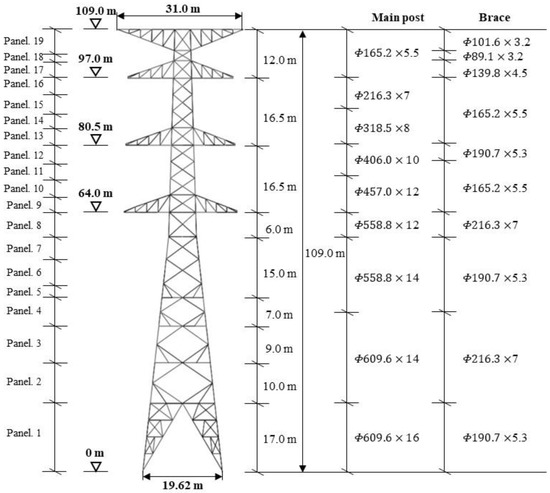
Figure 1.
Characteristics and dimensions of 765 kV transmission towers.
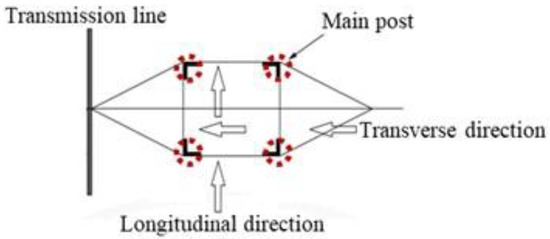
Figure 2.
Details of wind directions on transmission line.
The examined lattice transmission tower consists of two types of members: angle members and circular pipe section members. The cross-arm is composed of an angle section member, and the main post, braces, and horizontal members are composed of a circular pipe section member. We present the details of the members in Figure 3. The analytical model consists of sixteen L-angle cross sections and fifteen circular pipe cross sections. The yield strengths of the circular pipe section and angle section were 345 and 290 MPa, respectively, to perform the geometric nonlinear and inelastic analysis using a bilinear elastic–plastic model. The mass density (ρ), Young’s modulus (E), and Poisson’s ratio (ν) were 7850 kg/m3, 210 GPa, and 0.3, respectively. We summarize the section properties of the 765 kV transmission tower in Table 1. The horizontal angle of the wire was 30°, and the wind span and weight span were 450 and 800 m, respectively. For the conductors, we applied the cardinal aluminum conductor steel-reinforced model that is primarily used in 765 kV lattice transmission towers. The rated tensile strength was 150 kN, and the unit weight was 17.26 N/m. The rated tensile strength of the ground wire (AWS-200) was 126 kN, and the unit weight was 9.42 N/m. We summarize the conductor and ground wire properties in Table 2.
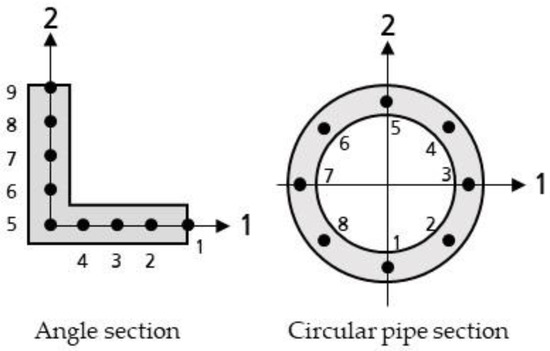
Figure 3.
Details of section members.

Table 1.
Section properties of 765 kV transmission tower.

Table 2.
Descriptions of conductors and ground wires.
The transmission tower consists of three parts: (1) the common part, (2) the body part, and (3) the leg part. In this study, we focused on the body parts of the transmission tower, and we applied changes to the horizontal members, brace members, and main posts to confirm the effects of the horizontal members on its overall behavior.
Using the commercial analysis software ABAQUS, we applied B31 beam elements with six degrees of freedom to the analytical models. We realistically modeled the inclined angle, shape, and orientation of the members using the beam elements. The connections between the members are fastened by multiple bolts. Some researchers have concluded that the multiple-bolt connection induces rotational constraints [44,45]. Reflecting the connection characteristics, we modeled the entire members of the examined transmission towers with the beam elements. In addition, we calculated the stress at the predefined reference points at the sections, which allowed us to assess the inelasticity of the members and structures during the nonlinear analysis because we assigned the beam sections (shown in Figure 3) for all the members.
We applied the load exerted on the ground wires as a concentrated load on the topmost arm. We used the multipoint constraint (MPC) and reference point to exert the load applied in the arms to support the conductors. The load components were transverse, longitudinal, and vertical loads. We evenly exerted the wind load applied to the transmission tower in a line load throughout the tower. In terms of the boundary conditions, we applied the fixed support conditions to the four legs in contact with the ground. We fixed all the degrees of freedom, such as the translational (Ux, Uy, Uz) and rotational (URx, URy, URz) constraints. We present the MPC-tie option and boundary conditions in Figure 4 and Figure 5, respectively.
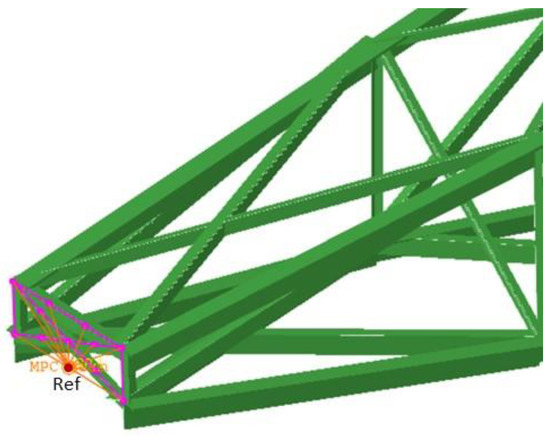
Figure 4.
Details of MPC-tie option.
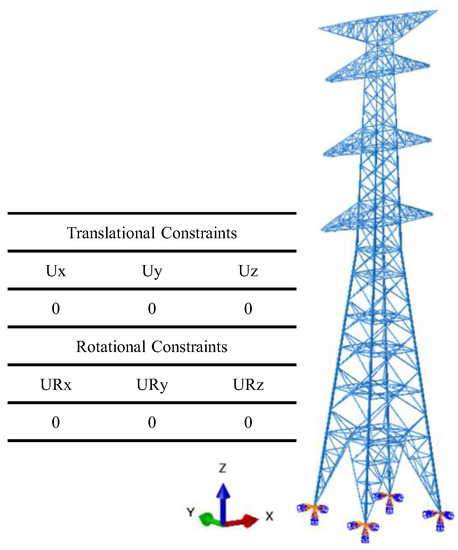
Figure 5.
Details of boundary conditions.
2.1.2. Parametric Variables of Analytical Model
We conducted parametric studies to analyze the effects of the horizontal and brace members on the load-carrying capacity improvement of the transmission tower. The variables of the research were the presence or absence of horizontal members, the shape of the braces, and the brace spacing. The role of the secondary members is to prevent distortion and maintain the shape of the structure. To confirm the torsional resistance and distortion of the transmission tower with the effects of the horizontal members, we applied variables indicating the presence or absence of horizontal members to the models. To affect the slenderness ratios of the members, we modulated the lengths of the main post and braces via their equal spacing and shape. However, we maintained the section properties of the brace and main post. We can categorize the brace shapes into two types: X bracing and K bracing. The X brace is a shape in which the braces, horizontal members, and main posts are gathered in one place. The K brace is a shape in which bracing exists between the horizontal members to support the middle part of the main post. We can categorize the equal brace spacing into four types: (1) five equal spacings; (2) four equal spacings; (3) three equal spacings; (4) two equal spacings. The respective spacings of the five, four, three, and two equal spacings per spacing were 8.2 m, 10.25 m, 13.67 m, and 20.5 m, respectively. We present the variables used in the analytical models in Figure 6, in which we depict the models with the equal brace spacings, with the differences owing to the brace shape and presence or absence of horizontal members. We performed structural analyses on a total of sixteen models. We present the positions of the horizontal members and the displacement coordinate system in Figure 7. We designated the transverse displacement at the front of the tower Ux, the longitudinal displacement at the front of the tower Uy, and the vertical displacement Uz. We designated the horizontal member of the lowest part Lv1, and we designated that of the uppermost part Lv6.
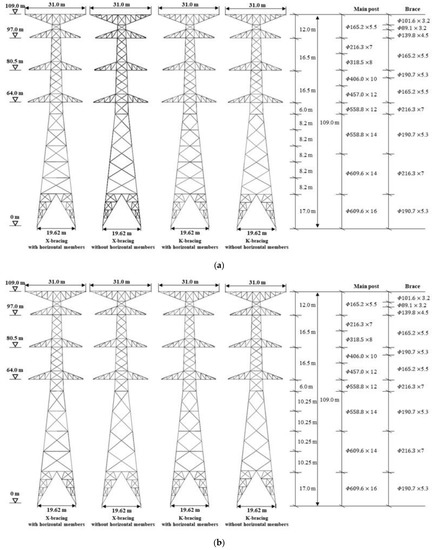
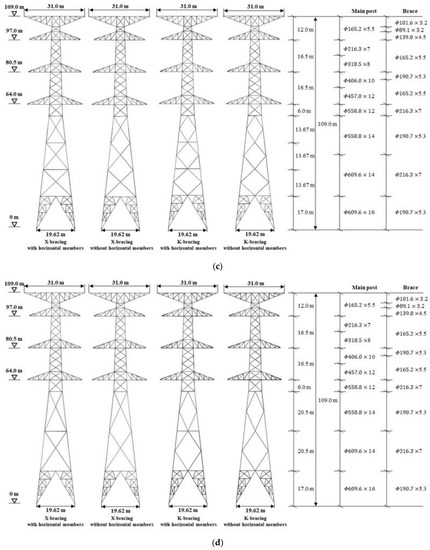
Figure 6.
Descriptions of parametric variables in analytical models: (a) models with five equal braces; (b) models with four equal braces; (c) models with three equal braces; (d) models with two equal braces.
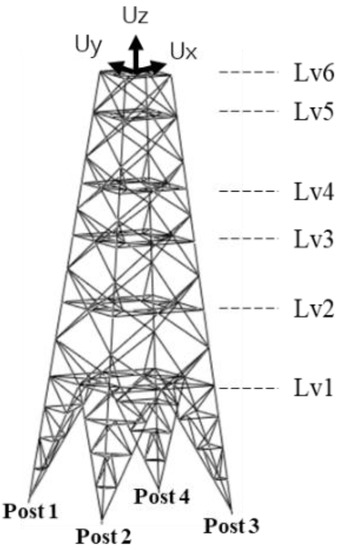
Figure 7.
Description of horizontal member positions and displacement coordinate system.
2.2. Analytical Load Combination and Method
2.2.1. Design Load and Load Combination
We exerted the wind load and broken wire load conditions on the lattice transmission tower based on the ASCE 74 (Guidelines for Electrical Line Structural Loading, 4th edition) design standard. We performed linear static, eigenvalue, and geometric nonlinear and inelastic analyses to analyze the effect of the horizontal and brace members on the structural behavior of the transmission tower, and on the enhancement of its load-carrying capacity. The horizontal members and braces maintain the distance between the main post, reduce the effective buckling length, and prevent the twisting of the constituting shape. We performed a linear static analysis to observe the effects of the horizontal and brace members on the resistance of the torsion and distortion of the tower due to the broken wire loads, which we categorized into three types: longitudinal, transverse, and vertical loads. We performed eigenvalue analyses to confirm whether the effective buckling length was reduced because of the horizontal members and braces, thereby improving the elastic buckling strength. Finally, we performed geometric nonlinear and inelastic analysis to explore the effect of the buckling strength improvement of the secondary members on the load-carrying capacity. We performed the eigenvalue and geometric nonlinear and inelastic analyses by applying the wind load condition to the transmission tower. We present the summary of the analysis methodologies used in this study and their objectives in Table 3, and we describe their details in the subsequent sections.

Table 3.
Summary of analytical investigation.
We needed to consider the local and topographical conditions, wind gusts, and tower shape and height to exert the loads used in the load combinations. The ASCE 74 recommends the local conditions of exposure C; thus, we calculated the load combinations for exposure C. We set a panel for each height of the tower, and we applied the wind load to the panels. In the research, the wind load is considered a common load condition, and the broken wire condition that induces torsional loads is considered an abnormal load condition. We applied the wire loads based on the wire tension calculation owing to the states of change. We could calculate it because we knew the conditions of the initial and final states. We calculated the wind load based on the ASCE 74. We required the following to calculate the wind loads: the wind pressure exposure coefficient (Kz); topographic factor (Kzt); reference 3-second wind speed for the 100-year mean recurrence interval (m/s) (V100); gust response factor for conductors, ground wires, and structures (G); force coefficient value (Cf); area projected onto the plane normal to the wind direction (m2) (A).
F = QKzKzt(V100)2GCf,
We can calculate the wind load using Equation (1). The Kzt value is 1.0 because we assumed the local exposure C exposure condition. We present the panel decision in Figure 1. The height is the middle height of the panel. We present the coefficients required to calculate the wind load in Table 4.

Table 4.
Details of wind load calculation.
2.2.2. Linear Static Analysis
We performed a linear static analysis to observe the distortion and torsional stiffness of the transmission tower owing to the horizontal and brace members. The role of the horizontal and brace members is to resist distortion and maintain the original shape, as well as to support the torsional load resistance applied in the main post. We applied broken wire load conditions inducing torsion to the transmission towers to analyze the effects of the horizontal and brace members on the torsional loads. We divided the broken wire loads into four types: (1) disconnection of the ground wire; (2) first-floor conductor; (3) second-floor conductor; (4) third-floor conductor. We designated the broken load condition of the ground wire GW, and we designated the broken load conditions of the first-, second-, and third-floor conductors CD1, CD2, and CD3, respectively. We present descriptions of the four load conditions with broken wires in Figure 8. V, T, and L are the vertical, lateral, and longitudinal loads, respectively. We present the values of the wire loads applied to the analytical model in Table 5.
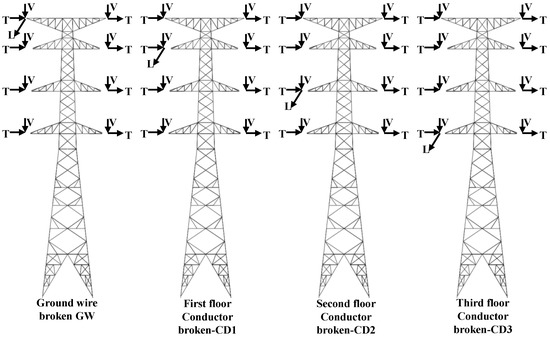
Figure 8.
Descriptions of load conditions with broken wires.

Table 5.
Values of broken wire loads (V, T, and L).
2.2.3. Eigenvalue Analysis
We can predict the elastic buckling strength and eigenmode of an ideal structure using eigenvalue analysis. We can use the eigenmode to predict the buckling mode based on geometric characteristics. We used the Lanczos eigensolver to confirm that the transmission tower had sufficient elastic buckling strength. We performed the eigenvalue analysis by avoiding the overlapping of the eigenvalues and eigenmodes. We analyzed the models with various variables to identify the factors that affected the elastic buckling strength of the transmission tower, and we studied the effects of the presence of horizontal members and the brace spacing and shape on the elastic buckling strength under 0° wind load (transverse direction) conditions.
2.2.4. Geometric Nonlinear and Inelastic Analysis
We performed geometric nonlinear and inelastic analyses of the models with or without horizontal members, and of models with different brace shapes and spacings, to analyze the ultimate behavior, weak members, and load-carrying capacity of the transmission tower under 0° wind load (transverse direction) conditions. We used the same load conditions as those used in the eigenvalue analysis. To consider the material features of the section, the yield strengths of the circular pipe section and angle section were 345 and 290 MPa, respectively, for the application of the bilinear elastic–plastic model. We used the arc length method for the geometric nonlinear and inelastic analysis. By analyzing the load–displacement curves in the models with various parameters, we confirmed the load-carrying capacities of the transmission tower owing to the effects of the horizontal and brace members.
3. Contribution of Secondary Members to Structural Behavior and Load-Carrying Capacity
3.1. Comparative Studies of Linear Static Behavior
By analyzing the parametric models owing to the horizontal members and shape of the braces, we determined the brace spacing, displacement of the horizontal position, and distortion of the section shape. To confirm the effect of the secondary members on the torsional load, we applied broken condition loads to the models. Among the load conditions caused by the broken wires, CD1 is the governing load. Therefore, we applied the CD1 load condition to the transmission tower to confirm the displacement and distortion. We evaluated the transverse, longitudinal, vertical, and torsional displacements at four points at the position where the horizontal members and main post meet. We present the displacements of the equal-spacing brace model under the effect of the secondary members in Table 6, Table 7, Table 8 and Table 9, in which we depict the transverse, longitudinal, vertical, and torsional displacements (Ux, Uy, Uz, and UΘ, respectively). For Posts 1–4 in Table 6, Table 7, Table 8 and Table 9, referring to Figure 7 will help the reader to understand the location of each post. In addition, we designated the horizontal member of the lowest part Lv1, and we designated the uppermost part Lv6. We present the deformed shapes of the transmission towers under the examined load combinations obtained by the linear elastic analysis in Figure 9 and Figure 10.

Table 6.
Brace spacing effects on X-bracing model displacement with horizontal members.

Table 7.
Brace spacing effects on X-bracing model displacement without horizontal members.

Table 8.
Brace spacing effects on K-bracing model displacement with horizontal members.

Table 9.
Brace spacing effects on K-bracing model displacement without horizontal members.

Figure 9.
Comparison of deformed shapes of transmission towers with X bracing under considered load combinations (scale factor: 10.0): (a) models with five equal spacings and horizontal members; (b) models with five equal spacings without horizontal members; (c) models with two equal spacings and horizontal members; (d) models with two equal spacings without horizontal members.
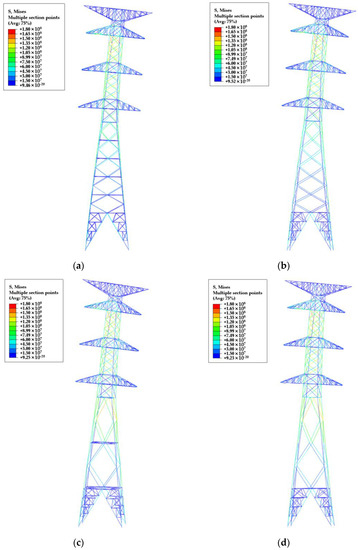
Figure 10.
Comparison of deformed shapes of transmission towers with K bracing under considered load combinations (scale factor: 10.0): (a) models with five equal spacings and horizontal members; (b) models with five equal spacings without horizontal members; (c) models with two equal spacings and horizontal members; (d) models with two equal spacings without horizontal members.
The effect of the horizontal members on the displacement of the structure was rare when the body part was supported by three, four, and five equally spaced braces. However, there was an effect on the displacement according to the shape of the brace in the model with two equal spacings, in which the slenderness ratio was increased and the effect of the horizontal member was negligible. In addition, the secondary members did not affect the torsional displacement in any of the models.
By applying the displacement presented in Table 6, Table 7, Table 8 and Table 9 to the basic position of the horizontal members, we determined the extent of the distortion caused by their presence. We present the extent of the distortion of the models with X bracing in Figure 11, and we present the extent of the distortion of the models with K bracing in Figure 12. We present the shape of the structure as a rectangle, according to the positions of the horizontal members. Although there was a slight movement in the positions of the horizontal members at the top point, it maintained a rectangular shape. Therefore, there were no distortion effects caused by the presence or absence of horizontal members in either the X- or K-bracing models.
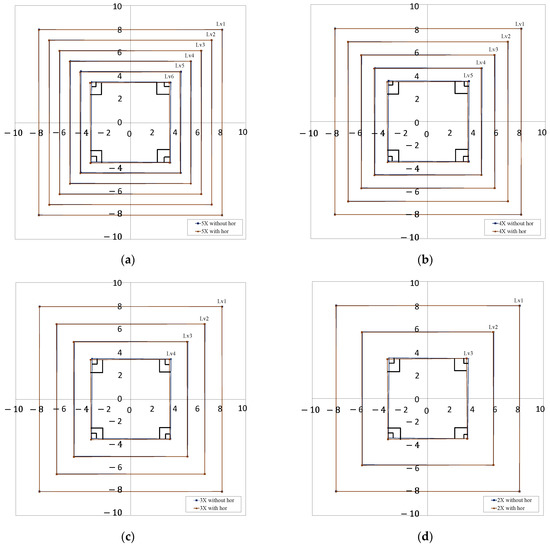
Figure 11.
Comparison of distortion effects of presence or absence of horizontal members in models with X bracing: (a) models with five equal spacings; (b) models with four equal spacings; (c) models with three equal spacings; (d) models with two equal spacings.
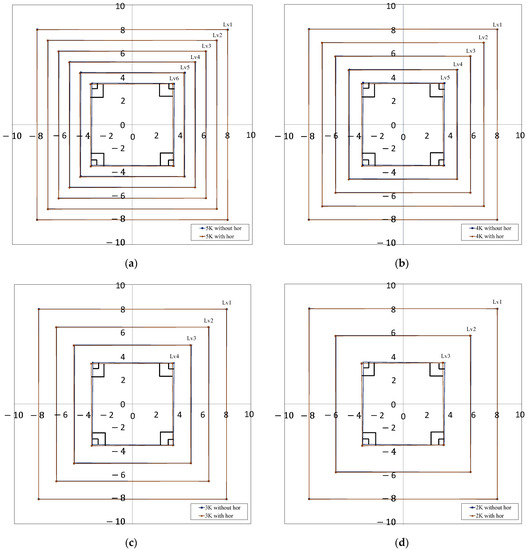
Figure 12.
Comparison of distortion effects of presence or absence of horizontal members in models with K bracing: (a) models with five equal spacings; (b) models with four equal spacings; (c) models with three equal spacings; (d) models with two equal spacings.
3.2. Comparative Studies of Eigenvalues and Corresponding Modes
By changing the brace shape and spacing, we confirmed the effect of the presence of horizontal members via the eigenvalues and eigenmodes. We present the eigenvalues and corresponding eigenmode shapes of the numerical models under the examined load combinations in Figure 13, Figure 14, Figure 15 and Figure 16. As shown in the figures, buckling occurred in each elastic buckling mode not only for the main post, but also for the braces and horizontal members. As the slenderness ratio decreased in the models with horizontal members, we observed the buckling of the main posts in the high-order mode. However, we generally observed the buckling of the main posts in the models without horizontal members in the low-order mode when compared with the models with horizontal members. Although the buckling mode occurred in some members, such as the local cross-arms and braces, in this study, we defined global buckling as the buckling that simultaneously occurs in the main post and braces of the body part.
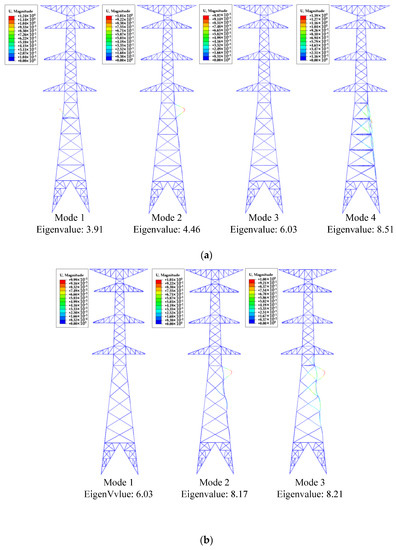
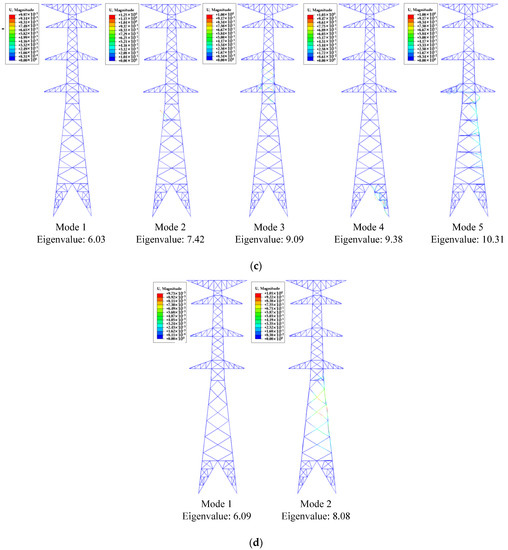
Figure 13.
Changes in eigenvalues and corresponding mode shapes of transmission tower models with five equal braces (scale factor: 5.0): (a) model with X bracing and horizontal members; (b) model with X bracing without horizontal members; (c) model with K bracing and horizontal members; (d) model with K bracing without horizontal members.
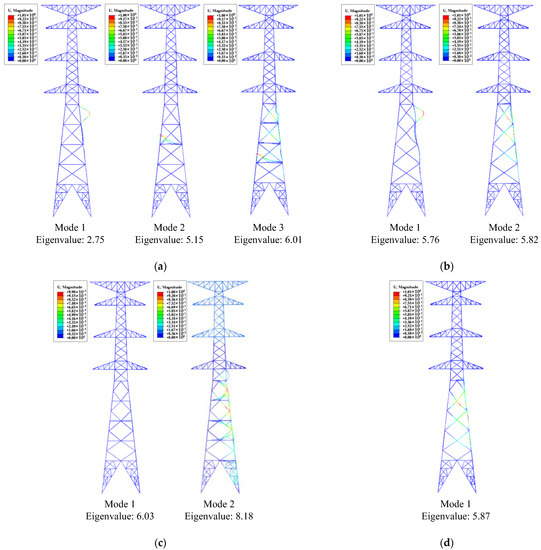
Figure 14.
Changes in eigenvalues and corresponding mode shapes of transmission tower models with four equal braces (scale factor: 5.0): (a) model with X bracing and horizontal members; (b) model with X bracing without horizontal members; (c) model with K bracing and horizontal members; (d) model with K bracing without horizontal members.
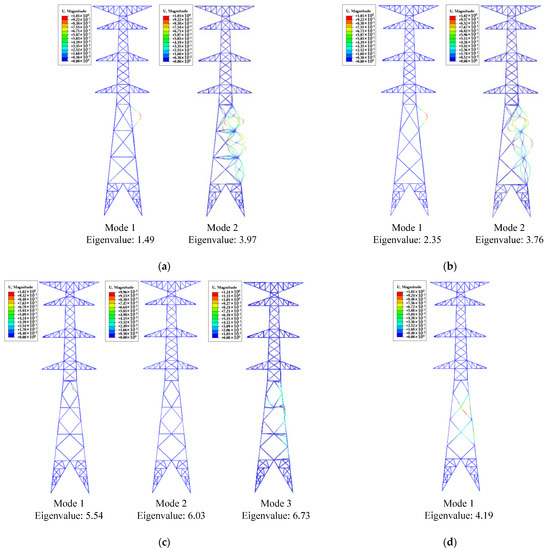
Figure 15.
Changes in eigenvalues and corresponding mode shapes of transmission tower models with three equal braces (scale factor: 5.0): (a) model with X bracing and horizontal members; (b) model with X bracing without horizontal members; (c) model with K bracing and horizontal members; (d) model with K bracing without horizontal members.
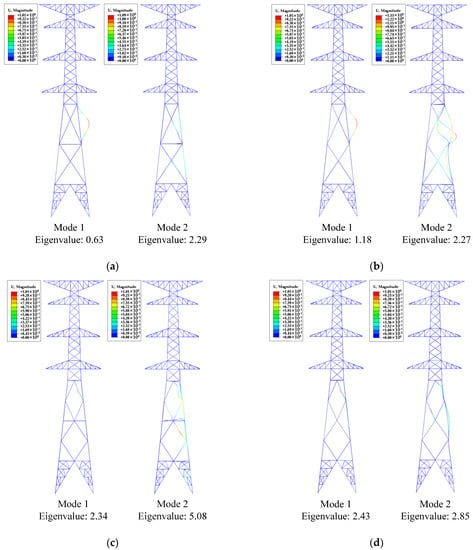
Figure 16.
Changes in eigenvalues and corresponding mode shapes of transmission tower models with two equal braces (scale factor: 5.0): (a) model with X bracing and horizontal members; (b) model with X bracing without horizontal members; (c) model with K bracing and horizontal members; (d) model with K bracing without horizontal members.
We present the differences in the elastic buckling strength based on the effect of the horizontal members and braces in Figure 17. We simultaneously confirmed the elastic buckling strength in the global buckling mode shape in which the buckling occurred in the main post and brace members. We present the elastic buckling strength values affected by the variables in Table 10. Because the elastic buckling strengths were affected by the slenderness ratios, we could confirm the slenderness ratio criteria of Chapter 3.4 in the ASCE 10-15 specification. According to the ASCE 10-15, the slenderness ratio of the main post should be less than or equal to 200, and that of the brace members should be less than or equal to 250. Among the analytical models used in this study, the model with two equal spacings was the model with the highest slenderness ratio (74.2), which satisfied the ASCE 10-15 specification.
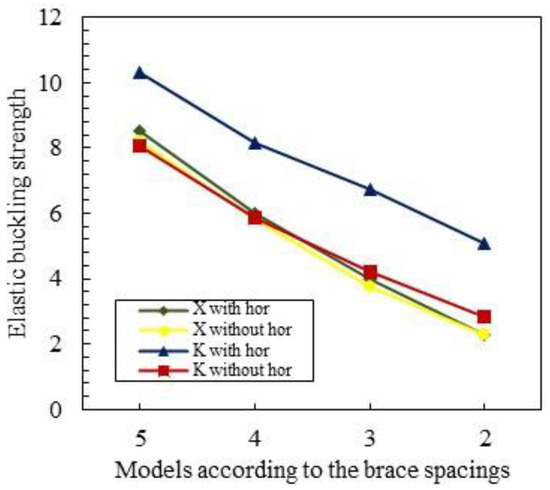
Figure 17.
Comparison of elastic buckling strengths based on effects of braces and horizontal members.

Table 10.
Comparison of elastic buckling strengths affected by variables.
The elastic buckling strength decreased as the spacing of the braces increased, and we confirmed the difference owing to the shape of the braces and the presence or absence of horizontal members. The rate of change in the elastic buckling strengths of the models with X bracing was from approximately 3 to 5%. However, for the structures with K bracing, the elastic buckling strength varied from 22 to 44%. As the slenderness ratio increased, the effect of the horizontal members was maximized in the models with K bracing. The elastic buckling strengths of the models with X bracing were less affected by the presence of the horizontal members than those with K bracing. The horizontal members reduced the effective buckling length to effectively enhance the elastic buckling strength in the models with K bracing.
3.3. Effects of Secondary Members on Load-Carrying Capacity
Many researchers have applied the initial imperfection in the finite element models to accurately confirm the buckling of structures [46,47,48,49]. In this study, we applied the initial imperfection using the buckling mode generated in the structure in the elastic buckling analysis. We defined the global buckling loads of the analytical models in the transmission tower considering initial geometric imperfections of L/1000 in the global mode. Here, L is the unsupported length of the main post in each model. We performed the geometric nonlinear and inelastic analysis to determine the effects of the brace shape and spacing and horizontal members on the ultimate behavior. We determined the models with five and two equal spacings as the representative models to demonstrate the load-carrying capacities of the different equal spacings. We present the deformed shapes of the transmission towers, which we obtained using geometric nonlinear and inelastic analysis, in Figure 18 and Figure 19. The figures clearly exhibit a gradual increase in the structural deformation with the increase in the external load. Because we conducted the geometric nonlinear and inelastic analysis, we could investigate the ultimate behaviors of each tower. According to the analysis results, the yield and inelastic buckling of the main posts were the primary causes of the ultimate behaviors of the examined transmission towers. The ultimate modes and failed members were different with respect to the details of the brace and horizontal members.
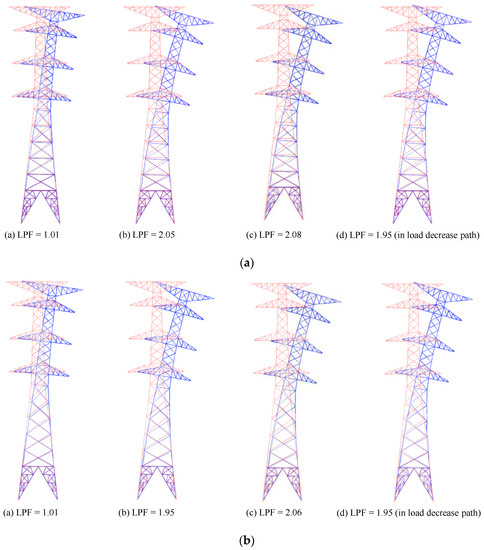
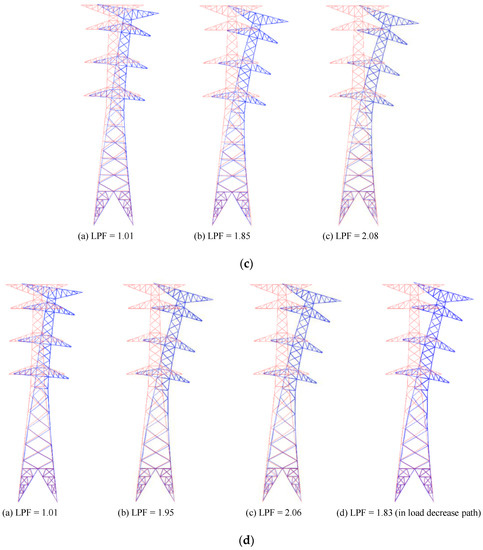
Figure 18.
Deformation progress of transmission towers with five equally spaced braces (scale factor: 10.0): (a) model with X bracing and horizontal members; (b) model with X bracing without horizontal members; (c) model with K bracing and horizontal members; (d) model with K bracing without horizontal members.
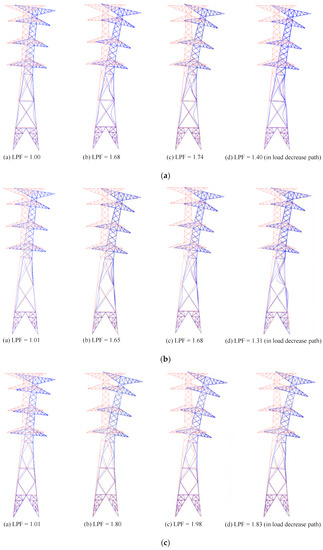

Figure 19.
Deformation progress of transmission towers with two equally spaced braces (scale factor: 10.0): (a) model with X bracing and horizontal members; (b) model with X bracing without horizontal members; (c) model with K bracing and horizontal members; (d) model with K bracing without horizontal members.
We evaluated the displacement at two points to present the load–displacement curves. The first point was the topmost section, where the maximum displacement occurs, and the second point was the section with maximum deformation. We illustrate these two points in Figure 20. The maximum deformation occurred on the main post, except for the model with an X bracing of two equal spacings, for which the point of maximum deformation was on the braces. We determined the load-carrying capacities using the load–displacement curves. We present the load–displacement curves affected by the bracing shape and spacing and horizontal members in Figure 21, Figure 22, Figure 23 and Figure 24. The y-axis represents the load proportionality factor (LPF), and the x-axis represents the displacement of the models. “Hor” in the legend refers to horizontal members. The bending points of the load–displacement curves correspond to the maximum LPFs. We defined the state of reaching the maximum LPF as the limit state in this study. We compared the maximum LPFs of the models to analyze their load-carrying capacities. We present the trends between the LPFs and brace spacings based on the effect of the horizontal members and braces in Figure 25. We present the maximum LPFs of the models affected by the horizontal and brace members in Table 11. The effect of the horizontal members was up to 3% in the models with X bracing. However, the effect of the horizontal members was up to 16% in the models with K bracing. In the models with five equal bracings and with sufficiently low slenderness ratios, the stiffnesses of the main posts and braces were sufficient to resist the load applied to the transmission tower. Therefore, the presence of horizontal members and the brace member shape did not affect the results. However, as the slenderness ratio increased, the effects of the horizontal members became dependent on the brace shape. In the models with X bracing, the horizontal member is located in the section in which the brace and main post are connected. Because the effective buckling length of the main post was not reduced, even if the horizontal member was removed, the horizontal members did not affect the load-carrying capacities of the two-equal-spacing models with large slenderness ratios. However, the horizontal members played a role in reducing the effective buckling length of the main posts in the models with K bracing and enhanced their load-carrying capacities. By analyzing the results of the geometric nonlinear and inelastic analysis, we confirmed that the horizontal members have a limited effect on the load-carrying capacity. When we decreased the brace spacing to increase the number of braces, there was little enhancement in the load-carrying capacities based on the effect of the horizontal members. However, when we induced K bracing by the proper arrangement of the horizontal members, the effective buckling length decreased, and the load-carrying capacities were markedly enhanced in the models with large slenderness ratios. In addition, by increasing the brace spacing, we can reduce the number of horizontal members and further simplify the configurations of transmission towers.
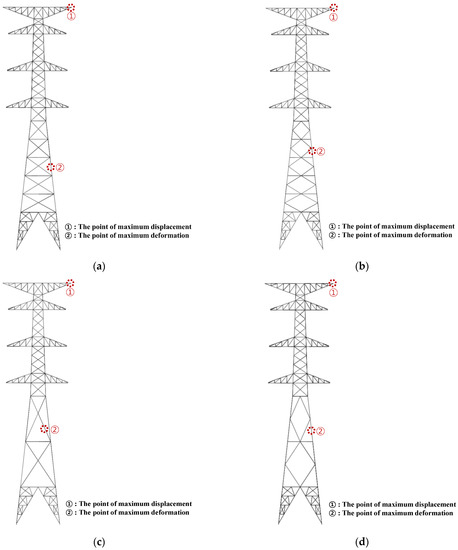
Figure 20.
Two points to determine load–displacement curves in analytical models: (a) model with X bracing of five equal spacings; (b) model with K bracing of five equal spacings; (c) model with X bracing of two equal spacings; (d) model with K bracing of two equal spacings.
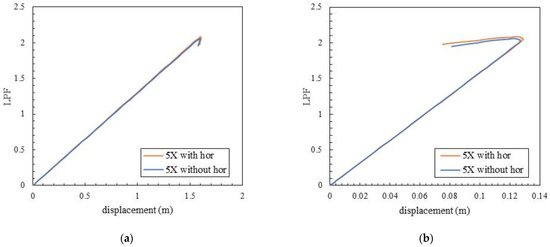
Figure 21.
Comparison of load–displacement curves in models with five equally spaced X braces with or without horizontal members: (a) topmost section; (b) main post section.
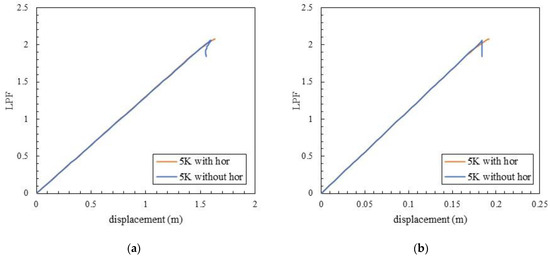
Figure 22.
Comparison of load–displacement curves in models with five equally spaced K braces with or without horizontal members: (a) topmost section; (b) main post section.
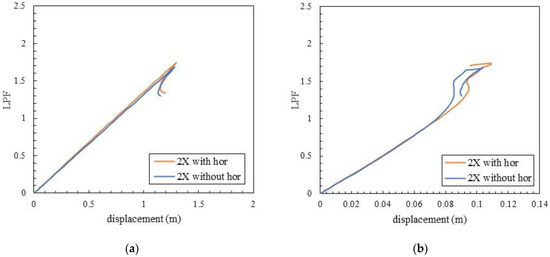
Figure 23.
Comparison of load–displacement curves in models with two equally spaced X braces with or without horizontal members: (a) topmost section; (b) brace section.
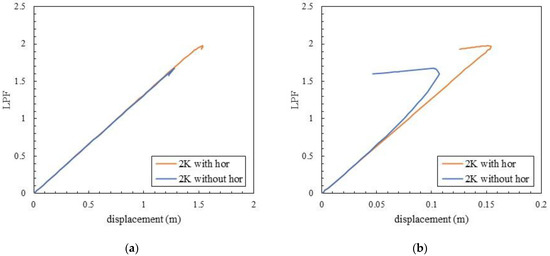
Figure 24.
Comparison of load–displacement curves in models with two equally spaced K braces with or without horizontal members: (a) topmost section; (b) brace section.
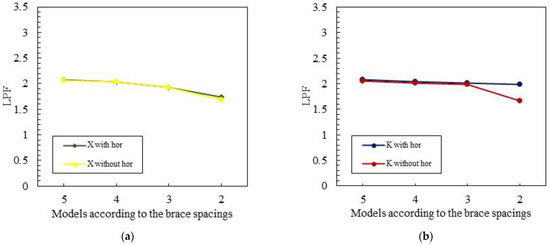
Figure 25.
Comparison of trends between LPF and brace spacings based on effects of brace and horizontal members: (a) models with X bracing; (b) models with K bracing.

Table 11.
Load-carrying capacities of models affected by parameters.
4. Conclusions
Transmission towers are designed with numerous auxiliary and reinforcing members; however, descriptions of the positions and shapes of the auxiliary and reinforcing members are only briefly explained or are not presented. On the one hand, as the number of members increases, the structural performance may be improved. On the other hand, excessive members may disadvantageously affect the future maintenance of the structure. Therefore, we thoroughly observed the structural role of the secondary members by analyzing the torsional stiffness, elastic buckling strength, and load-carrying capacity. We reached the conclusions by performing linear static, eigenvalue, and geometric material nonlinear analyses. Based on the comparative study, we concluded that bracing directly affects the structural behaviors and load-carrying capacities of transmission towers, while the effect of the horizontal members is limited. If the bracing is sufficiently erected, then we can substantially reduce the number of horizontal members to simplify the structural configuration.
According to the linear static analysis, there were no substantial effects of the horizontal members or braces on the displacement or distortion of the transmission towers when we applied the torsional loads. Regardless of the presence or absence of horizontal members, the structural behaviors of the towers were nearly the same.
According to the results of the eigenvalue analysis, the rates of change in the elastic buckling strengths of the models with X bracing were from approximately 3 to 5%. An equal-spacing model with X bracing was not affected by the horizontal members; however, brace spacing did affect the eigenvalues. The brace spacing and horizontal members affected the results of the elastic buckling strengths in the models with K bracing. The rates of change of the models with K bracing were from about 22 to 44%. As the slenderness ratio increased, the effect of the horizontal members increased. The horizontal members reduced the effective buckling length to effectively enhance the elastic buckling strength of the K bracing.
By analyzing the load–displacement curves obtained by the geometric nonlinear and inelastic analysis, we found that the load-carrying capacities of the models with X bracing were affected by the brace spacing and were not affected by the horizontal members. However, the effect of the horizontal members substantially enhanced the load-carrying capacities of the models with K bracing and large slenderness ratios. Bracing formations with large slenderness ratios are effective to increase the load-carrying capacity. Furthermore, by increasing the brace spacing, we can reduce the number of horizontal members and simplify the transmission tower members.
According to a comparison of the results of the eigenvalue analysis and those of the geometric nonlinear and inelastic analysis, the ultimate strength was lower in the latter because the material features were reflected. In other words, the material features were more dominant than the geometric features in the analysis.
In this study, we evaluated the effect of the horizontal members on the overall behavior of large-capacity transmission towers. In addition to the horizontal members, we also assessed the brace shape and spacing, which could affect the overall behavior of the structures. As the main posts were made of circular pipes in the models in this study, the application of the results is limited only to models with circular pipe main posts. In addition, we did not investigate the effects of the horizontal members on the dynamic characteristics of the transmission towers. Therefore, we require further studies for the different types of the transmission towers considering both the static and dynamic characteristics.
Author Contributions
Conceptualization, J.H.K. and S.K.; methodology, P.K., W.S.H. and S.K.; software, Y.J.K. and S.K.; validation, J.H.K. and S.K.; formal analysis, P.K. and W.S.H.; investigation, P.K., W.S.H. and J.L.; resources, Y.J.K. and S.K.; data curation, P.K.; writing—original draft preparation, P.K.; writing—review and editing, J.L. and S.K.; visualization, P.K.; supervision, S.K.; project administration, J.H.K. and S.K.; funding acquisition, S.K. Please turn to the CRediT taxonomy for the term explanations. All authors have read and agreed to the published version of the manuscript.
Funding
This study was supported by the Korea Electric Power Research Institute (KEPRI) (CX72200091), and by a National Research Foundation of Korea (NRF) grant funded by the Korean government (MSIT) (No. NRF-2021R1A5A1032433).
Data Availability Statement
The data of the study are contained within the article.
Acknowledgments
This study was supported by the Korea Electric Power Research Institute (KEPRI) (CX72200091), and by a National Research Foundation of Korea (NRF) grant funded by the Korean government (MSIT) (No. NRF-2021R1A5A1032433).
Conflicts of Interest
The authors declare no conflict of interest.
References
- Xu, Y.L.; Lin, J.F.; Zhan, S.; Wang, F.Y. Multistage damage detection of a transmission tower: Numerical investigation and experimental validation. Struct. Control Health Monit. 2019, 26, e2366. [Google Scholar] [CrossRef]
- Mahamid, M.; Tasbahji, T.; Tort, C. Investigating Different Horizontal Bracing Schemes on the Deflection and Behavior of Latticed Steel Transmission Line Towers; Structures Congress: Orlando, FL, USA, 2019; pp. 299–308. [Google Scholar] [CrossRef]
- de Souza, R.R.; Miguel, L.F.F.; Kaminski, J., Jr.; Lopez, R.H. Topology design recommendations of transmission line towers to minimize the bolt slippage effect. Eng. Struct. 2019, 178, 286–297. [Google Scholar] [CrossRef]
- Bezas, M.-Z.; Jaspart, J.-P.; Vayas, I.; Demonceau, J.-F. Design recommendations for the stability of transmission steel lattice towers. Eng. Struct. 2022, 252, 113603. [Google Scholar] [CrossRef]
- Ebid, A.M.; El-Aghoury, M.A.; Onyelowe, K.C. Estimating the Optimum Weight for Latticed Power-Transmission Towers Using Different (AI) Techniques. Designs 2022, 6, 62. [Google Scholar] [CrossRef]
- American Society of Civil Engineers. ASCE Manual 74, Guidelines for Electrical Transmission Line Structural Loading, 4th ed.; ASCE: New York, NY, USA, 2020. [Google Scholar]
- Dreyer, W. Special Features in the Design of Transmission Tower Lines as Imposed by Electrical Conditions. Trans. Am. Inst. Electr. Eng. 1923, XLII, 962–966. [Google Scholar] [CrossRef]
- Taniwaki, K.; Ohkubo, S. Optimal synthesis method for transmission tower truss structures subjected to static and seismic loads. Struct. Multidiscip. Optim. 2004, 26, 441–454. [Google Scholar] [CrossRef]
- Kaminski, J.; Riera, J.; de Menezes, R.; Miguel, L.F. Model uncertainty in the assessment of transmission line towers subjected to cable rupture. Eng. Struct. 2008, 30, 2935–2944. [Google Scholar] [CrossRef]
- Ju, Y.-Z.; Xue, Q.-L.; Li, H. Failure Analysis of Transmission Tower under the Effect of Ice-Covered Power Transmission Line. In Proceedings of the 2009 First International Conference on Information Science and Engineering, Nanjing, China, 26–28 December 2009; pp. 4301–4304. [Google Scholar] [CrossRef]
- Zheng, H.-D.; Fan, J.; Long, X.-H. Analysis of the seismic collapse of a high-rise power transmission tower structure. J. Constr. Steel Res. 2017, 134, 180–193. [Google Scholar] [CrossRef]
- Cai, M.; Yang, X.; Huang, H.; Zhou, L. Investigation on Galloping of D-Shape Iced 6-Bundle Conductors in Transmission Tower Line. KSCE J. Civ. Eng. 2020, 24, 1799–1809. [Google Scholar] [CrossRef]
- Govindasamy, N.; Syamsir, A.; Mardi, N.H.; Malek, M.A. Effect of tsunami load by earthquake at manila trench on transmission tower. Ain Shams Eng. J. 2021, 12, 3593–3602. [Google Scholar] [CrossRef]
- Mahmoudi, A.; Nasrollahzadeh, K.; Jafari, M.A. Probabilistic failure analysis of 400 kV transmission tower-line system subjected to wind and ice hazards. Wind Struct. 2021, 33, 251–264. [Google Scholar]
- Savory, E.; Parke, G.A.; Zeinoddini, M.; Toy, N.; Disney, P. Modelling of tornado and microburst-induced wind loading and failure of a lattice transmission tower. Eng. Struct. 2001, 23, 365–375. [Google Scholar] [CrossRef]
- Shehata, A.; El Damatty, A.; Savory, E. Finite element modeling of transmission line under downburst wind loading. Finite Elements Anal. Des. 2005, 42, 71–89. [Google Scholar] [CrossRef]
- Zhang, Z.; Li, H.; Li, G.; Wang, W.; Tian, L. The Numerical Analysis of Transmission Tower-Line System Wind-Induced Collapsed Performance. Math. Probl. Eng. 2013, 2013, 413275. [Google Scholar] [CrossRef]
- Tian, L.; Zeng, Y. Parametric Study of Tuned Mass Dampers for Long Span Transmission Tower-Line System under Wind Loads. Shock. Vib. 2016, 2016, 4965056. [Google Scholar] [CrossRef]
- Tapia-Hernández, E.; Ibarra-González, S.; De-León-Escobedo, D. Collapse mechanisms of power towers under wind loading. Struct. Infrastruct. Eng. 2017, 13, 766–782. [Google Scholar] [CrossRef]
- Tian, L.; Pan, H.; Qui, C.; Ma, R.; Yu, Q. Wind-induced collapse analysis of long-span transmission tower-line system considering the member buckling effect. Adv. Struct. Eng. 2019, 22, 30–41. [Google Scholar] [CrossRef]
- Yang, X.; Lei, Y.; Liu, L.; Huang, J. Simulation of nonstationary wind in one-spatial dimension with time-varying coherence by wavenumber-frequency spectrum and application to transmission line. Struct. Eng. Mech. 2020, 75, 425–434. [Google Scholar]
- Tian, L.; Dong, X.; Pan, H.; Gao, G.; Xin, A. Critical seismic incidence angle of transmission tower based on shaking table tests. Struct. Eng. Mech. 2020, 76, 251–267. [Google Scholar]
- Tapia-Hernández, E.; De-León-Escobedo, D. Vulnerability of transmission towers under intense wind loads. Struct. Infrastruct. Eng. 2021, 18, 1235–1250. [Google Scholar] [CrossRef]
- Rao, N.P.; Knight, G.S.; Lakshmanan, N.; Iyer, N.R. Investigation of transmission line tower failures. Eng. Fail. Anal. 2010, 17, 1127–1141. [Google Scholar]
- Rao, N.P.; Knight, G.S.; Mohan, S.; Lakshmanan, N. Studies on failure of transmission line towers in testing. Eng. Struct. 2012, 35, 55–70. [Google Scholar]
- Zhang, Z.; Xie, Q. Failure analysis of transmission tower subjected to strong wind load. J. Constr. Steel Res. 2019, 160, 271–279. [Google Scholar] [CrossRef]
- Albermani, F.; Kitipornchai, S. Numerical simulation of structural behaviour of transmission towers. Thin-Walled Struct. 2003, 41, 167–177. [Google Scholar] [CrossRef]
- Albermani, F.; Mahendran, M.; Kitipornchai, S. Upgrading of transmission towers using a diaphragm bracing system. Eng. Struct. 2004, 26, 735–744. [Google Scholar] [CrossRef]
- Xie, Q.; Sun, L. Failure mechanism and retrofitting strategy of transmission tower structures under ice load. J. Constr. Steel Res. 2012, 74, 26–36. [Google Scholar] [CrossRef]
- Xie, Q.; Sun, L. Experimental Study on the Mechanical Behavior and Failure Mechanism of a Latticed Steel Transmission Tower. Eng. Struct. 2013, 139, 1009–1018. [Google Scholar] [CrossRef]
- Cai, Y.; Xie, Q.; Xue, S. Effects of additional diaphragms on the wind-resistant performance of power transmission tower. In Proceedings of the 2016 World Congress on Advances in Civil, Environmental, and Materials Research (ACEM16), Jeju Island, Republic of Korea, 28 August–1 September 2016. [Google Scholar]
- Chen, J.; Cao, S.; Xian, Q. Optimization Design of Transmission Tower Based on Intelligent Selection. IOP Conf. Ser. Mater. Sci. Eng. 2019, 473, 012035. [Google Scholar] [CrossRef]
- Meshmesha, H.M.; Kennedy, J.B.; Sennah, K.; Moradi, S. Static and dynamic analysis of guyed steel lattice towers. Struct. Eng. Mech. 2019, 69, 567–577. [Google Scholar]
- Sheppard, D.J.; Palmer, A.C. Optimal design of transmission towers by dynamic programming. Comput. Struct. 1972, 2, 455–468. [Google Scholar] [CrossRef]
- Natarajan, K.; Santhakumar, A. Reliability-based optimization of transmission line towers. Comput. Struct. 1995, 55, 387–403. [Google Scholar] [CrossRef]
- Mathakari, S.; Gardoni, P.; Agarwal, P.; Raich, A.; Haukaas, T. Reliability-Based Optimal Design of Electrical Transmission Towers Using Multi-Objective Genetic Algorithms. Comput. Civ. Infrastruct. Eng. 2007, 22, 282–292. [Google Scholar] [CrossRef]
- de Souza, R.R.; Fadel Miguel, L.F.; Lopez, R.H.; Miguel, L.F.F.; Torii, A.J. A procedure for the size, shape and topology optimization of transmission line tower structures. Eng. Struct. 2016, 111, 162–184. [Google Scholar] [CrossRef]
- Srihitha, S.; Rao, B.C.M. Analysis of transmission towers for optimal bracing configuration. J. Struct. Eng. 2016, 5, 1. [Google Scholar]
- Taheri, F.; Ghasemi, M.R.; Dizangian, B. Practical optimization of power transmission towers using the RBF-based ABC algorithm. Struct. Eng. Mech. 2020, 73, 463–479. [Google Scholar]
- Khodzhaiev, M.; Reuter, U. Optimization design of transmission tower based on intelligent selection. Eng. Struct. 2021, 240, 112306. [Google Scholar] [CrossRef]
- Grzywinski, M. Optimization of spatial truss towers based on Rao algorithms. Struct. Eng. Mech. 2022, 81, 367–378. [Google Scholar]
- American Society of Civil Engineers. Design of Latticed Steel Transmission Structure; ASCE: New York, NY, USA, 2015. [Google Scholar]
- Hamidreza, G. Effect of Joint Flexibility on the Nonlinear Static and Dynamic Behaviour of Offshore Jacket Platforms/Hamidreza Golabi. Ph.D. Thesis, University of Malaya, Kuala Lumpur, Malaysia, 2015. [Google Scholar]
- Al-Bermani, F.G.A.; Kitipornchai, S. Nonlinear Analysis of Thin-Walled Structures Using Least Element/Member. Eng. Struct. 1990, 116, 215–234. [Google Scholar] [CrossRef]
- Kroeker, D. Structural Analysis of Transmission Towers with Connection Slip Modeling. Master’s Thesis, University of Manitoba, Winnipeg, MB, Canada, 2000. [Google Scholar]
- Jeddi, A.B.; Shafieezadeh, A.; Hur, J.; Ha, J.; Hahm, D.; Kim, M. Multi-hazard typhoon and earthquake collapse fragility models for transmission towers: An active learning reliability approach using gradient boosting classifiers. Earthq. Eng. Struct. Dyn. 2022, 51, 3552–3573. [Google Scholar] [CrossRef]
- Uriz, P.; Filippou, F.C.; Mahin, S.A. Model for cyclic inelastic buckling of steel braces. J. Struct. Eng. 2008, 134, 619–628. [Google Scholar] [CrossRef]
- Darestani, Y.M.; Shafieezadeh, A.; Cha, K. Effect of modelling complexities on extreme wind hazard performance of steel lattice transmission towers. Struct. Infrastruct. Eng. 2020, 16, 898–915. [Google Scholar] [CrossRef]
- Wang, J.; Li, H.N.; Fu, X.; Li, Q. Geometric imperfections and ultimate capacity analysis of a steel lattice transmission tower. J. Constr. Steel Res. 2021, 183, 106734. [Google Scholar] [CrossRef]
Disclaimer/Publisher’s Note: The statements, opinions and data contained in all publications are solely those of the individual author(s) and contributor(s) and not of MDPI and/or the editor(s). MDPI and/or the editor(s) disclaim responsibility for any injury to people or property resulting from any ideas, methods, instructions or products referred to in the content. |
© 2023 by the authors. Licensee MDPI, Basel, Switzerland. This article is an open access article distributed under the terms and conditions of the Creative Commons Attribution (CC BY) license (https://creativecommons.org/licenses/by/4.0/).